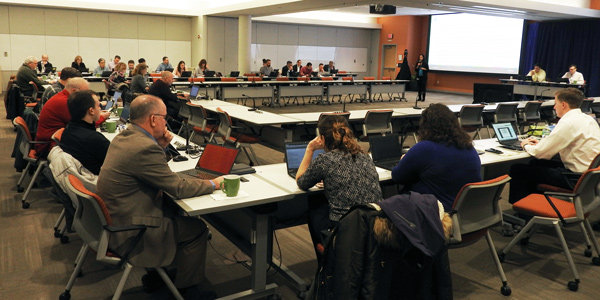VALLEY FORGE, Pa. — PJM will hold its spring restoration drill May 15-16, staff told attendees at last week’s Operating Committee meeting. Invitations will be emailed March 19 to the contacts listed in transmission owners’ restoration plans for the transmission operator, generation operator and training liaisons, PJM’s Alpa Jani said.
Primary Frequency Response
PJM’s Glen Boyle said stakeholders’ work in the Primary Frequency Response Senior Task Force became more complicated and urgent after FERC issued Order 842, which requires all new generation that receives an interconnection agreement to provide primary frequency response. (See FERC Finalizes Frequency Response Requirement.)
The order silenced any debate about new facilities, so staff will instead focus on what should be required of existing units. The order could delay the PFRSTF’s work, but the group plans to vote on proposals after its March 21 meeting. Stakeholder endorsement votes will likely be completed in June.
Unit-specific Parameter Adjustments
Jani also reviewed the statistics about the number of unit-specific parameter adjustment requests that PJM received this year. The request period closed on Feb. 28.
All final determinations will be made by April 15 so they can be implemented by the start of the delivery year on June 1. Jani noted that soak time information is only for reference this year but will be added as a parameter and integrated next year.
Resilience Update

PJM’s Dean Manno reviewed the RTO’s resilience roadmap and highlighted the next steps for 2018. PJM is evaluating the needs for “extreme events,” he said, including reserves and regulation requirements, transmission loading and triggers. Staff are also planning to review the weather/environmental and sabotage/terrorism emergencies sections of Manual 13 to see if anything should be added.
30-Minute Reserves
PJM’s Vince Stefanowicz explained staff’s thought process on developing a real-time 30-minute reserves product and announced that a problem statement and issue charge will be forthcoming in April.
Currently, 30-minute reserves are only procured in the day-ahead market, so when more primary reserves are needed, they’re moved in from secondary reserves, which only serves to reduce secondary reserves rather than bringing in more units. The new product would achieve that, he said, “not just move things from secondary into primary.”
Dave Mabry with the PJM Industrial Customer Coalition said that “perhaps a bigger audience” would be necessary to make such changes and asked if the Market Implementation Committee would become involved.
“Conceptually, I’m in agreement with you,” said PJM’s Dave Souder, the interim chair of the Operating Committee. He said the plan is to figure out the operational needs, then determine what other committees need to be involved.
Implementing DER Ride Through
The RTO is hoping TOs will take the lead on implementing “ride through” for distributed energy resources, PJM’s Andrew Levitt said. Ride through is the process of remaining connected to the grid during abnormal conditions. Despite being a “challenge” for large generators, Levitt said they’re required to do it while DERs are not.
Today, DERs can trip off very quickly and potentially over a wide variety of variables. However, there are already 4,000 MW of distributed solar generation in PJM today with expectations of that tripling in the next three years, making it a significant issue if they all trip when the grid is having issues.
“We think ride through is critical for DER,” Levitt said.
PJM recently published a draft revision of standards for DERs that would require ride through. However, it has no control over the net-metered solar that accounts for all the DER growth.
“We’re looking to follow the utilities’ lead on this topic … but we also anticipate a public stakeholder process” to support stability bulk energy supply and move toward a single standard for implementation, Levitt said.
Changing Tier 1 Reserve Estimates
PJM’s Joe Ciabattoni unveiled planned revisions to how Tier 1 reserves are estimated to address stakeholders concerns about major overestimates. (See “Investigating Improvements Based on Additional Cold Response Details,” PJM Operating Committee Briefs: Feb. 6, 2018.)
The RTO is proposing to cap spin max at a unit’s economic minimum and require that the spin ramp rate equal the economic ramp rate, he said.
“We find that during spin events this is an issue,” he said.
A TO representative who asked not to be named voiced concerns about reducing too much spin and asked that additional data be presented to explain the problem. Ciabattoni agreed.
“I just want to make sure we’re actually seeing a problem there as opposed to fixing a problem that doesn’t exist because there’s no way a resource could tell if there’s going to be a Tier 2 payment,” the TO representative said.
Tom Blair of the Independent Market Monitor said the issue is exacerbated because of how the reserve market is set up.
“There is no penalty for Tier 1 synchronized reserve not responding. There is, however, a significant incentive to overestimate your Tier 1 reserve,” he said.
Blair explained that the reserve market is set up so that units can earn enough money that they still make a profit even with the penalties that occur if they don’t respond when called upon.
“I think directionally this is worthwhile, probably helpful,” said Carl Johnson, representing the PJM Public Power Coalition.
Calpine’s David “Scarp” Scarpignato said another issue is that scarcity pricing is not being triggered when it needs to be and that “the issue is much broader than this.”
RAS Removed
Commonwealth Edison is removing the Davis Creek remedial action scheme (RAS). The plan was needed to prevent thermal overloads in the event of losing a 345-kV line to the substation by auto-closing a 345-kV bus tie at the station.
A supplemental project to expand the 345-kV bus at the substation is expected to be completed by the end of the year.
— Rory D. Sweeney






